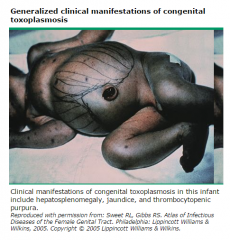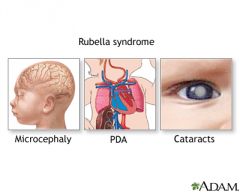![]()
![]()
![]()
Use LEFT and RIGHT arrow keys to navigate between flashcards;
Use UP and DOWN arrow keys to flip the card;
H to show hint;
A reads text to speech;
8 Cards in this Set
- Front
- Back
|
what are the congental infections |
T - toxoplasmosis O - (enteroviruses, varicella zoster virus, and parvovirus B19) R - rubella C - cmv H - herpes S - syphilis |
|
|
Clinical manifestations that are suggestive of toxoplasmosis |
|
|
|
pther clinical signs of congenital toxoplasmosis |

other sigins
|
|
|
congenital toxoplasmosis - picture
|

|
|
|
congenital syphilis clinical manifestations |
abortions / still births
|
|
|
Congenital rubella syndrome
|
|
|
|
Congenital rubella syndrome - picture
|

|
|
|
Congenital cytomegalovirus
|
90 percent of infants with congenital CMV infection are asymptomatic at birth.
|

